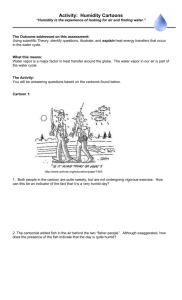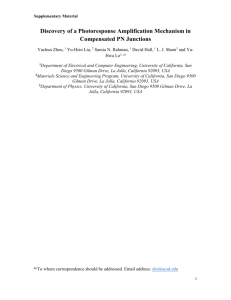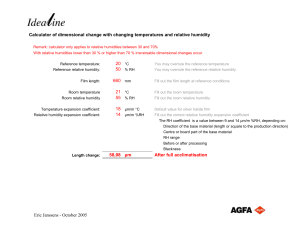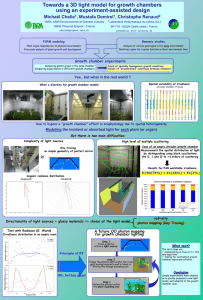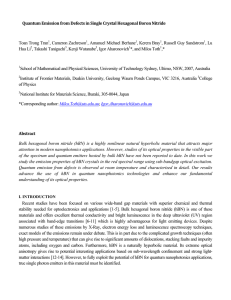Glow of humid air induced by incident UV
advertisement
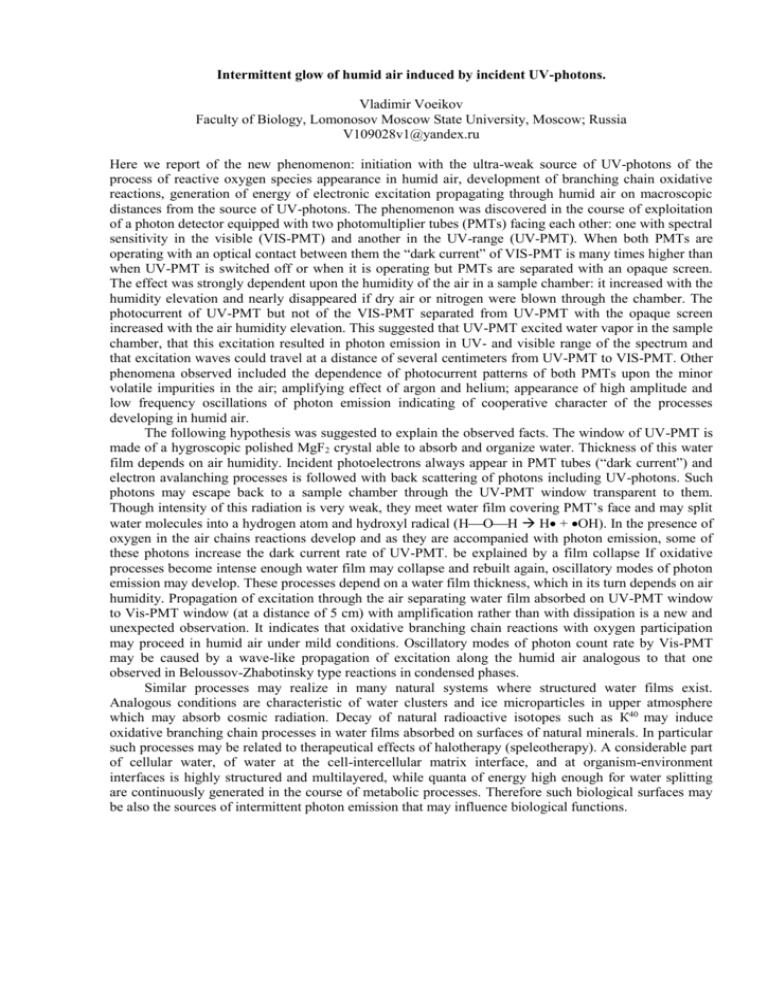
Intermittent glow of humid air induced by incident UV-photons. Vladimir Voeikov Faculty of Biology, Lomonosov Moscow State University, Moscow; Russia V109028v1@yandex.ru Here we report of the new phenomenon: initiation with the ultra-weak source of UV-photons of the process of reactive oxygen species appearance in humid air, development of branching chain oxidative reactions, generation of energy of electronic excitation propagating through humid air on macroscopic distances from the source of UV-photons. The phenomenon was discovered in the course of exploitation of a photon detector equipped with two photomultiplier tubes (PMTs) facing each other: one with spectral sensitivity in the visible (VIS-PMT) and another in the UV-range (UV-PMT). When both PMTs are operating with an optical contact between them the “dark current” of VIS-PMT is many times higher than when UV-PMT is switched off or when it is operating but PMTs are separated with an opaque screen. The effect was strongly dependent upon the humidity of the air in a sample chamber: it increased with the humidity elevation and nearly disappeared if dry air or nitrogen were blown through the chamber. The photocurrent of UV-PMT but not of the VIS-PMT separated from UV-PMT with the opaque screen increased with the air humidity elevation. This suggested that UV-PMT excited water vapor in the sample chamber, that this excitation resulted in photon emission in UV- and visible range of the spectrum and that excitation waves could travel at a distance of several centimeters from UV-PMT to VIS-PMT. Other phenomena observed included the dependence of photocurrent patterns of both PMTs upon the minor volatile impurities in the air; amplifying effect of argon and helium; appearance of high amplitude and low frequency oscillations of photon emission indicating of cooperative character of the processes developing in humid air. The following hypothesis was suggested to explain the observed facts. The window of UV-PMT is made of a hygroscopic polished MgF2 crystal able to absorb and organize water. Thickness of this water film depends on air humidity. Incident photoelectrons always appear in PMT tubes (“dark current”) and electron avalanching processes is followed with back scattering of photons including UV-photons. Such photons may escape back to a sample chamber through the UV-PMT window transparent to them. Though intensity of this radiation is very weak, they meet water film covering PMT’s face and may split water molecules into a hydrogen atom and hydroxyl radical (НОН H + ОН). In the presence of oxygen in the air chains reactions develop and as they are accompanied with photon emission, some of these photons increase the dark current rate of UV-PMT. be explained by a film collapse If oxidative processes become intense enough water film may collapse and rebuilt again, oscillatory modes of photon emission may develop. These processes depend on a water film thickness, which in its turn depends on air humidity. Propagation of excitation through the air separating water film absorbed on UV-PMT window to Vis-PMT window (at a distance of 5 cm) with amplification rather than with dissipation is a new and unexpected observation. It indicates that oxidative branching chain reactions with oxygen participation may proceed in humid air under mild conditions. Oscillatory modes of photon count rate by Vis-PMT may be caused by a wave-like propagation of excitation along the humid air analogous to that one observed in Beloussov-Zhabotinsky type reactions in condensed phases. Similar processes may realize in many natural systems where structured water films exist. Analogous conditions are characteristic of water clusters and ice microparticles in upper atmosphere which may absorb cosmic radiation. Decay of natural radioactive isotopes such as К40 may induce oxidative branching chain processes in water films absorbed on surfaces of natural minerals. In particular such processes may be related to therapeutical effects of halotherapy (speleotherapy). A considerable part of cellular water, of water at the cell-intercellular matrix interface, and at organism-environment interfaces is highly structured and multilayered, while quanta of energy high enough for water splitting are continuously generated in the course of metabolic processes. Therefore such biological surfaces may be also the sources of intermittent photon emission that may influence biological functions.
